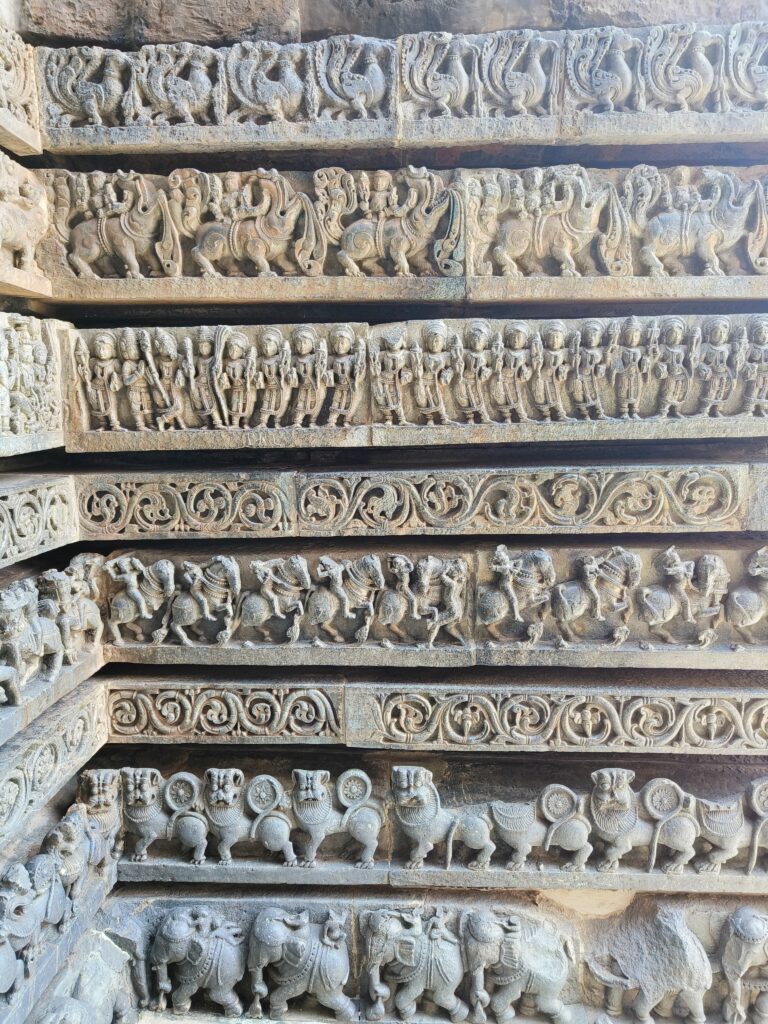
In the region of Southern Karnataka (Mysuru), the temples built under the Hoysala rulers developed a distinct style of their own known as Hoysala School of Art by combining Vesara and Dravidian style of architecture. It developed in the period from 1050-1300 AD. With the prominent sites being Halebidu, Belur, Somanathapura. These group of temples are listed on the tentative list of UNESCO World Heritage Sites.
Significant Features:-
The temples were built on the upraised platform called Jagati used as Pradakshinapatha. The platform shaped in a star like pattern known as Stellate Plan. The main building material used was Soft Soapstone (Chlorite Schist). The prominence was laid on the decorations of temple on both interior and exterior walls through intricately carved sculptures. Even the ornamentation on deities were carved elaborately. All the chambers of temples had shikharas which were interconnected by an horizontal lines and moldings. The temple walls of Hoysala Empire are dotted with events from Hindu epics Ramayana, Mahabharata and Bhagavata Purana.
Hoysalas built numerous temples throughout their empire but barely around 92 temples survived which are on the path of ruins. The main sites like Belur Chennakesava Temple was built by King Vishnuvardhana, and Halebidu by his minister Ketumalla. Here is the description of the twin temples of Halebidu. Ketumalla being Shiva devotee, in memory of King and Queen built this temple. There are two Shivalingas in the shrine, one in the Kings name Hoysaleshwara and other in the Queen’s name Shantaleshwara. This is an twin temple known as DWIKUTA in Sanskrit [Belur – Ekakuta, single temple and Somanathapura – Trikuta, three temples]. This Hoysalas made Kuta. This Temple construction was started in 1121 AD and continued for around 190 years. Halebidu was the capital of Hoysalas with its old name Dwarasamudra. During 14th century Halebidu was attacked twice and plundered by Delhi Sultanates and aftermath the fall of the empire the temples fell largely into the state of ruins and neglect until it drew the attention of ASI post independence.

To briefly describe on the specific architecture of Hoysaleshwara temple I would describe carvings on the eastern side of the temple which drew my attention. On the eastern side of the temple there lie 11 lines of wall depiction. First line is the Elephants line in a moving state, 2nd line – lions, 3rd line – flower climbers, and 4th – Horses. It is said that these 4 lines of depiction holds importance because the King should have all these qualities in him.

Elephant symbolizes strength, lion for courage , flower climbers for decoration and horse for quickness. One of the 11 lines depicts the story of Samudra Manthana, another line depicts an imaginary animal Makara. Makara is an combination of 7 animals being Pigs body, Lions legs, Crocodiles mouth, Elephants trunk, Cows ears, Monkeys eyes and Peacocks tails. The other themes of the temple depictions tell each story on the life of empire. The each theme of temple gives moral story to the life, which is applicable for even today.

The Hoysala Temple Architecture is known for its exquisite carvings on both inner and exterior walls of the temple. Every traveler to the sites of the empire will get an unique experience , exploring the great architecture of Hoysalas. Every traveler has to put his whole heart to learn the knowledge of Hoysala architecture. The ornamentation on the temples of Hoysalas tells the architectural richness of the empire . Unfortunately , despite governments and ASI efforts, the temples are in the path of ruins. Not only of Hoysala empire most of the ancient temples are in the ruin state. So it is the duty of every Visitor to preserve our rich heritage and culture, so be an responsible traveler and the explore the heritage .

